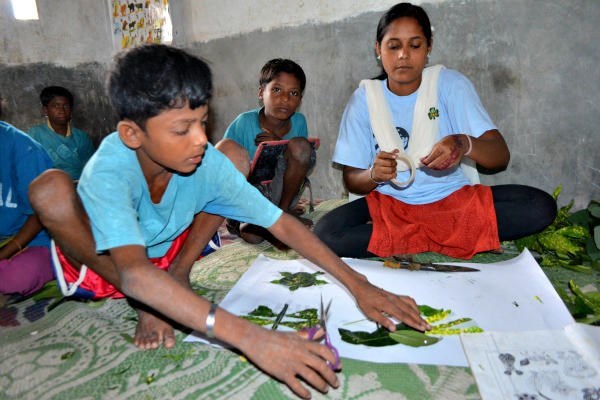 |
| Children study in a class located near the brickmaking kilns in Kolkata, India. Workers who know how to read and count will be better able to make sure they are treated fairly by employers.
Simon Roughneen |
KOLKATA, INDIA
On the outskirts of India's third-largest city, 5,000 partly blackened chimneys stand 100 feet high, belching smoke into the sky over millions of reddened bricks below. Some of the bricks are stacked neatly into huge square-cornered stacks, and still more, innumerable, are piled roughly – some broken, some chipped and cracked, as if tipped wantonly from a wheelbarrow.
Here around 1.25 million low-caste migrant workers and their dependents spend six months each year dredging clay from nearby lakes or molding bricks under the scorching sun, or lugging back-breaking hods. It is seasonal work, done by India's lowest castes, or in some cases, dirt-poor immigrants from neighboring Bangladesh.
Weather-beaten Ram Dayal, whose home is in Gazpar in Uttar Pradesh, a 24-hour train ride away, says has worked these kilns for 25 years. Asked his age, he laughs and says he doesn't know exactly. "I have a son about your age though," he tells me.
He's getting ready to go home – "in two or three days" – as the monsoon season approaches, rains that make brick-baking impossible. For now, however, he spends 12 hours a day fueling and stoking a huge kiln, baking around 400,000 bricks at a time. "We are paid 4,700 rupees [$84] a month," he says.
The soft, wet bricks are stacked in a basketball court-sized area around the stack. With venting space between the wet bricks, they are covered in a layer of stone and baked for two weeks. Keeping the fires lit, Ram Dayal and Murai Rajbal share two, six-hour shifts over each 24-hour period. In between, they mostly sleep in a nearby shack, which, astonishingly, sits right on top of the baking mass of bricks and a short stone's throw from the chimney stack behind.
The afternoon shift from 12 noon to 6 p.m. is the worst, with daytime temperatures nearing 40 C (104 F.) and relative humidity between 70 and 80 percent. That's before you factor in the heat from the vast kiln, though.
"You get used to it," shrugs Murai Rajbal, his hands black from soot and brow laced with smoke-darkened sweat. He guesses his own age to be "around 41 or 42." With "only 12 years working here," he's a relative newcomer compared with Ram Dayal.
The migrants and their children often have little or no formal schooling, and, given that most of the workers – except those working the fires– are paid according to how many bricks they make or can carry, being able to count is key to ensuring a fair day's pay.
Since 2006 the nongovernmental organization GOAL, based in Ireland, has worked alongside local authorities and other NGOs to improve living standards for 3,500 children and 8,500 adults who live and work at the kilns for half the year. Dora Chauduri is the assistant country director for GOAL's India program, which works in tandem with West Bengal's local government – particularly the social welfare department and the women and child development department.
Watching as GOAL-funded teachers give basic literacy and numeracy lessons to children at the kilns – in a small, steamy classroom – she says that "as well as supporting the migrant workers with much-needed safe drinking water and sanitation, such as latrines, GOAL works with the Narayantala Mass Communication Society [a local West Bengal NGO] to help with basic literacy and numeracy for migrant children and help the migrants gain awareness of their rights under the law."
India's economy has grown by 7 to 8 percent on average per year for most of the two decades since the government ditched a socialist economic model in 1991 and opted for a range of free-market reforms. The country still has hundreds of millions of poor, however, and a caste system that many human rights groups regard as discriminatory. So many Indians are left out, even as the country booms and affluence becomes a more common sight in big cities such as Kolkata.
Among the marginalized are Jyoti, aged 20, and her daughter Puja, 3. Sitting in a tiny waist-high hovel fashioned out of bricks lifted and dried from the ground outside, mother and child sit and eat kichiri, a lunch mix of rice and dhal (lentils).
As the brick season ends, and the rainy closes in, they too are readying to travel home, to Jharkhand state in the northeast of India. Jyoti and Puja are from the Munda tribe, numbering around 2 million and scattered across India's northeast and into Bangladesh.
"It is tough work here for me and my husband," says Jyoti, who adds that she has been married "for four or five years." Every day Puja joins the other children for basic learning in the morning. "This allows us to work on the bricks," Jyoti says.
A single, rope-thick braid grows on the back of young Puja's head, woven into a sort of dreadlock and looking almost too heavy for the child's neck to support. Jyoti says she had tried for several years to conceive before Puja was born. "We will cut the braid off when she is 5 years old," she says. "It will be an offering to [Hindu god] Shiva, in thanks for me finally having a child."
Page created on 10/2/2012 12:00:00 AM
Last edited 1/5/2017 8:40:50 PM
